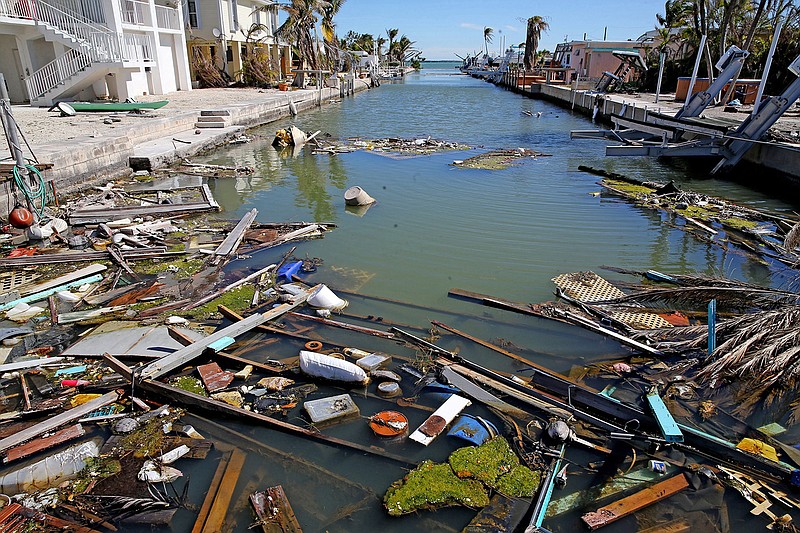MIAMI - A bird's eye look at the Florida Keys is all it takes to understand that little stands between the chain of islands and the sea.
A new federal study all but confirms that there are few big, structural options to keep the Keys safe from the stronger hurricanes and rising seas that climate change is expected to bring. The answer, it suggests, is a combination of elevation and retreat.
In a presentation shown to Monroe County Commissioners last week, the Army Corps of Engineers outlined a $3 billion strategy to protect the Keys. The only new construction measure considered is adding additional rocks on either side of U.S. 1 in six key spots. The rest of the plan is a combination of elevating homes, businesses and essential buildings and "retreat" in the form of government-funded buyouts.
"It is less traditional that our usual coastal studies," said Susan Layton, the Corps chief of planning and policy for the Norfolk District and lead for the Monroe County project. "You really cannot keep the water back, so really a lot more of this project is how do we react to the water and live with the water to make the Keys a viable place to live and make that lifestyle available for as many years as possible."
In Miami-Dade, the federal engineering team is proposing dramatic construction fixes, including 10 to 13-foot walls along the coast, surge barriers at the mouths of rivers and thousands of home elevations and buyouts.
The Keys plan would skip the massive walls and instead pay to floodproof or even elevate all the "critical infrastructure" in the Keys, which includes hospitals, fire and police stations and water treatment facilities.
It's unclear precisely how many private homes and businesses could face the prospect of elevation or buyouts. Army Corps officials offered estimates during an unrecorded webinar with Monroe County officials in January, but they were not included in last week's presentation and Corps and county officials declined to disclose them.
"We don't have numbers that we have enough confidence in to release," said Layton.
Those numbers will include the 62 Keys properties already in line to sell their homes to the state after damage from 2017's Hurricane Irma. The state has considered re-opening the pot of money after considerable interest in the Keys. The homes are expected to be sold and demolished in about a year, although homeowners are allowed to back out of the process at any time.
But unlike the state buyout program, which will purchase homes sporadically around the Keys, the Corps plans to buy out a concentrated area to avoid "checkerboarding" of city services and flood protection.
"Part of our analysis is making sure they're grouped appropriately and you're not buying them here or there," she said.
However, those buyouts could come with a catch.
If the county wants to tap into federal funds for buyouts, Army Corps policy mandates that homeowners targeted for buyouts will either have to voluntarily sell their property or Monroe would have to agree to seize and buy properties through eminent domain, an always controversial choice in a state with a Republican political leadership that has consistently opposed condemnations. Layton said that has been Corps policy since 2016 but acknowledges its a "sensitive topic."
"We don't ever go straight to condemnation. We always start with negotiating and coordinating with homeowners and looking for willing sellers," she said. "It's a lot of process before you would ever get to that point."
Monroe officials appeared anxious about the possibility of using eminent domain. They asked the Corps to meet with all the cities in the region and get their feedback.
"What really disturbed me in the briefing was the concept of mandatory acquisition and eminent domain. I don't know if we want to have the conversation now, if that's a nonstarter for us," said Monroe County Mayor Heather Carruthers.
Monroe County's Chief Resilience Officer Rhonda Haag said county staff drafted a letter to the Corps asking to make the buyouts voluntary but it hasn't been sent yet.
The only Corps project that's been funded since the 2016 policy change is a $13 million study of Mill Creek, Tenn. There, the Corps identified 89 homes for buyouts.
The plan also didn't examine the potential costs of elevating roads, not even U.S. 1. That decision would be made by Florida's Department of Transportation.
At a December climate conference, the Keys debuted its initial estimates for raising roads high enough to stay dry in the face of rising seas. It was staggering - about $60 million a mile. That price was high enough that officials admitted they can't afford to raise every road, so they may need to turn to buyouts or creative solutions like using boats to commute.
Haag called this Army Corps project, combined with the county's road raising strategy a "one, two punch" for the Keys in helping the region fight back against the effects of sea level rise.
The Army Corps will return to Monroe Commissioners in May for their feedback and to publish an official draft plan. That plan is open for public comment and won't be finalized until September 2021.
After that, it's up to congress to approve and fund the plan.
"It could be a very long process. It's just the way the federal bureaucracy works," Haag said. "If we don't keep moving and we don't get in line then we wouldn't see federal funding for the plan and the projects associated with it."

